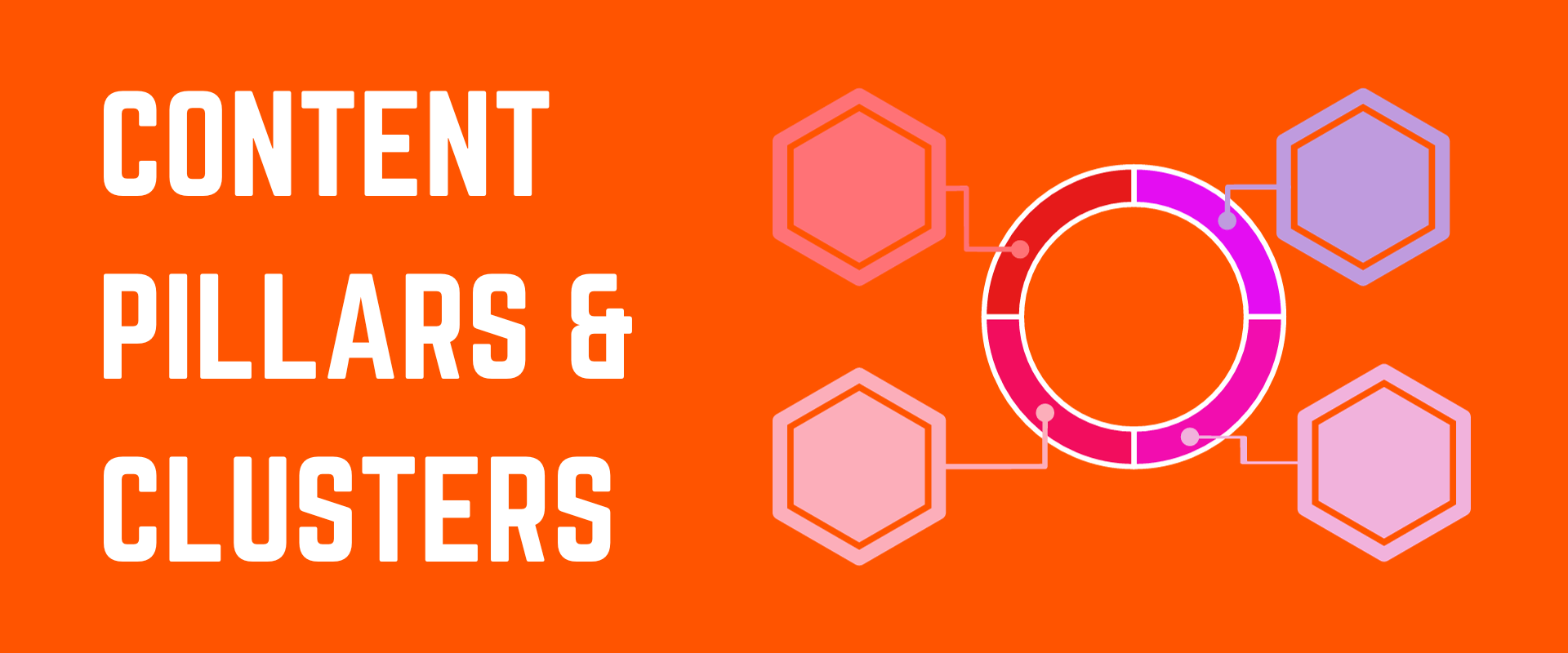
Listen to this article now:
Are you contemplating using content pillars and clusters in your blog writing strategy?
If you are, then you're on the right track.
High-quality and well-researched content pillars and clusters are blogging strategies that can drive traffic and position your brand as an authority in your field.
So, let’s delve into why pillar and cluster content matters and how you can use them to create and implement a successful content strategy!
Table of Contents
- What Are Content Pillars and Clusters?
- The Importance of Content Pillars & Clusters
- What Are the Different Types of Content Pillars?
- 6 Steps to Develop & Implement a Content Strategy With Pillars & Clusters
- Enhance Your Brand Presence With Content Pillars & Clusters
- Content Development Pros - Content Writing Experts
- Connect With CDP Today!
What Are Content Pillars and Clusters?
Content pillars serve as the main topic or theme around which your content strategy is centered around. It’s the foundational pillar that supports your overall brand or business narrative across platforms.
The central topic you decide on should be broad, covering the main aspects of your industry or niche. For instance if you’re in the digital marketing industry, “SEO” could be one of your content pillars.
Your chosen content pillars help establish your expertise and attract readers or your target audience interested in the wider theme.
Content clusters, on the other hand, revolve around subtopics related to your content pillar. These subtopics are more specific and provide in-depth information on various aspects of the main theme.
Continuing with the SEO example, cluster topics for this content pillar could be related to local SEO, technical SEO, on-page SEO, internal links, keywords, and more.
These interconnected pages work together to provide a comprehensive understanding of the primary topic.
Work With Seasoned Blog Writing Experts
CDP’s blog writers will create and implement a comprehensive content plan with the right content pillars and clusters to help you unlock your goals.
The Importance of Content Pillars & Clusters
Imagine walking into a library with towering shelves overflowing with books, crammed with information but lacking a clear path to navigate it effectively.
You wander aimlessly, overwhelmed by the sheer content volume and unable to find what you need.
Now, picture a curated exhibit with a central display that focuses on a specific theme, with surrounding books delving deeper into related topics.
You effortlessly navigate the exhibit, drawn in by its seamless structure. In fact, it makes you eager to explore and find the information you need.
This is the difference between traditional blog writing which is usually devoid of any structure and a strategic approach to content production that uses content pillars and clusters.

3 Benefits of Content Pillars & Clusters
Here are some compelling benefits of using content pillars and clusters, underscoring the importance of this content strategy:
- Better SEO Performance: Search engines love well-structured content. Content pillars and clusters boost organic rankings and drive traffic with their robust interlinking system that offers context to search engines. They build a strong website architecture, helping you rank higher on relevant and diverse keywords.
- Enhanced User Experience: Implementing content pillars and clusters helps structure your content, making it easy to find, manage, and understand. It helps your readers in navigating the vast array of information available on your blog and find what they need quickly, keeping them engaged and increasing the likelihood of conversion.
- Established Authority: In-depth pillars and targeted clusters showcase your knowledge and build trust, making you a thought leader in your field. Consistent and valuable content establishes your authority, helping you become the go-to source of information for your target audience.
What Are the Different Types of Content Pillars?
There are three primary content pillar pages in blog writing:
- Guides
- How-Tos
- What Is
Let’s dive into what each type of content pillar entails:
Guides
A "guide" pillar page is designed to offer readers a comprehensive understanding of a specific topic, providing them with all the essential information they need on that subject.
Many popular guide pillar pages focus on evergreen topics, and they can be titled with words like “The Ultimate Guide to X” or “X 101 for Beginners.”
They can be as detailed as an encyclopedic exploration of a subject.
The cluster pages associated with the guide pillar expand on specific aspects within the main topic, offering authoritative coverage of questions or particular topics that the audience is keen on learning more about.
These cluster pages serve to delve deeper into the nuances of the subject, providing a more in-depth exploration based on the interests and inquiries of the audience.
Here’s an example of a guide type content pillar from our blog:

Read this blog post here: Mobile App Development: From Ideation to Product Launch & Beyond!
How-Tos
A how-to pillar page aims to educate and empower readers by providing guidance through actionable steps to accomplish a specific task or solving a particular problem.
Think of it as a tutorial or a step-by-step article that breaks down everything your audience needs to know to achieve a goal.
In contrast to covering a broad topic, as seen in the guide pillar page, the how-to pillar focuses on offering more detailed, granular information.
Depending on the topic and the search intent, a how-to pillar page could describe a process suitable for both beginner and experienced audiences.
Here’s an example of a how-to post from our blog that can be used as a content pillar :

Read this blog post here: How to Produce Content at Scale for Your Marketing Agency
What Is
True to its name, a What Is pillar page is dedicated to defining and thoroughly explaining a specific topic.
This approach proves beneficial when aiming to rank for a keyword tailored to a beginner audience.
In a “what is” post, you introduce the topic and provide substantial materials that delve into it comprehensively.
To effectively use this type of pillar page, especially if targeting keywords with a healthy search volume, you can break down complex subjects into chapters or segments.
This strategy can lead to an increase in traffic, considering how often users turn to search engines with questions that start with, "What is?" and find themselves directed to a pillar page that provides all the necessary information about the topic.
In the case of evergreen topics, leveraging a “what is” pillar page can help you build a robust backlink profile and enhance your standing as an expert within your industry or niche.
It serves as a valuable resource for those seeking foundational knowledge on a particular subject.
Here’s an example of a what is pillar post from our blog that offers an in-depth understanding of website migration:

Read this blog post here: Website Migration: Navigating the Transition and SEO Implications Expertly
6 Steps to Develop & Implement a Content Strategy With Pillars & Clusters
You must think strategically when developing and implementing a content strategy rooted in content pillars and clusters.
Let’s dive into the steps you can take to create and apply this strategy:
Step 1: Define Your Content Pillar Topic and Outline Cluster Page Topics
Successful content pillars typically share two key traits:
- They delve into a topic that engages, is relevant, and holds significance for their target audience.
- The chosen keyword has a healthy search volume and carries promising ranking potential.
Choose Your Content Pillar Topic
Before choosing a content pillar topic, understand your audience through research. Rely on customer surveys, interviews, industry insights, and social media and community platforms to identify their pain points.
Buyer personas based on online behaviors, demographics, and preferences can further enhance this understanding.
Once you have insights into your audience, pinpoint the topic for your pillar page. Ensure it's substantial enough to serve as a hub for related content.
You can also use AI tools to generate a list of overarching topics that will resonate with your readers and address the most common questions and concerns shared by your clients.
This ensures your pillar topic is not only relevant but also tailored to the specific needs and interests of your audience.
Generate a List of Topics for Your Cluster Pages
Once you have a decent content pillar topic, create the topics for your cluster pages. For instance, if your pillar topic is “blog writing,” your cluster content can revolve around the following topics:
- How to write engaging blog post headings
- What’s the key to boosting blog engagement and conversions
- Blog writing woes and how to tackle them
- X blog writing tips for better traffic
- How to use CTAs in your blog posts & more!
Remember, when creating content clusters, you don’t have to stick to the blog medium, you can look into eBooks, videos, news articles, guides, whitepapers, and more for a well-rounded content strategy.

Step 2: Conduct a Content Audit on Your Website
Next, you must perform a content audit on your website.
This crucial step helps to:
- Identify Existing Content: Determine whether you already have pages on your website that align with the topics outlined for your pillar and cluster content. This helps in optimizing existing pages rather than creating duplicate content.
- Prevent Duplicate Content: The audit helps prevent the unintentional creation of duplicate content or the cannibalization of previously published material. This ensures a streamlined and cohesive content strategy.
- Recycle & Repurpose Old Content: If you find relevant content on your website, you can give it a new form for a more cohesive content strategy. For instance, you can turn your blog posts into videos and vice versa.
By conducting a content audit, you'll gain a clear understanding of your current content landscape.
It will help you make informed decisions on optimizing, creating, or reshaping content to align with your pillar and cluster strategy.
Create Content That Converts – Download the Ultimate Blog Writing Guide!
Step 3: Check Out Your Competitors
Unless your content is about something completely new and tied to your distinct services, chances are others are competing in the same area.
To stay ahead of the curve, it's essential to conduct a competitive content analysis. This helps you spot opportunities, gaps, and advantages for your own content strategy.
One effective way to surpass the competition is by enhancing existing content.
Look for places where you can make improvements, especially in areas where topics are lacking or pages are thin. This gives you a jumpstart in creating value driven content.
Here’s a simple breakdown of what to do:
- Examine the key content strategy elements of each competitor.
- Generate ideas and set benchmarks for your own strategy.
- Summarize the main findings and develop practical insights.

Step 4: Craft Your Content Pillar
Now, it's time to dive into content creation!
Plan the layout of your content pillar page. Gather all the potential questions your pillar page aims to address and use them to structure your blog writing process.
Begin by searching your target keywords on Google and analyzing the content that ranks on the first page. Take note of the formats, structure, subsections, and questions covered in those pages.
Explore additional resources like "related searches," "people also ask," and "things to know" sections for more insights.
This way, you can create a comprehensive and well-organized pillar page that effectively addresses your audience's queries and interests.
Step 5: Link Your Content Pillars & Clusters
Linking your cluster content to your pillar page (as well as between different cluster pages) is crucial for your overall information architecture.
For successful internal linking, your content pillar page must have comprehensive information on the topic. This way, you can strategically incorporate highly relevant links to cluster pages.
Ideally, your cluster pages and your linking strategy should be devised to answer specific questions tied to search intent.
While the pillar page should serve as a one-stop-shop for all information, the interlinking structure should help the reader access in-depth information on each subsection.
Seamless interlinking will enhance user experience and provide valuable context for search engines, contributing to improved visibility and relevance.

Step 6: Share and Boost Your Pillar Content
Even if your content is exceptional, it won't benefit anyone if it remains undiscovered. Hence, having a well-thought-out content promotion plan is crucial for your overall strategy.
After investing significant time in blog writing to ensure your content is top-notch, you wouldn't want to share it just once or on one platform only, right?
Incorporating different distribution and promotion strategies ensures that your content pillars and clusters reach a broader audience and maximizes their impact.
Here are some key channels and methods for promoting your pillar content both internally and externally:
Social Media Promotion
Content pillars and clusters will offer your social media team a wealth of content to populate their calendars. Break down and repurpose content from your pillars for your audience on social media platforms.
Experiment with different posts, stories, graphics, and CTAs for continuous content distribution and engagement. If you have a paid promotion budget, consider boosting your top-performing organic posts to reach new audiences.
Pitch to Influencers
Reach out to thought leaders, bloggers, and relevant influencers who might be interested in sharing your content. Identify key linking opportunities for pitching.
Instead of exclusively pitching your entire pillar content, identify specific cluster topics, pages, visuals, or other elements that can capture the interest of potential backlink prospects.
Your pillar content, covering the topic in-depth, holds significant potential for acquiring backlinks.
Email Blasts
Leverage email marketing to highlight cluster topics and create multiple email newsletters to redirect your email contacts back to your website.
This not only has the potential to generate immediate leads but also reinforces your expertise and drives traffic to your site.

Enhance Your Brand Presence With Content Pillars & Clusters
Content pillars and clusters can empower you to adopt a more strategic content writing and marketing approach, focusing on delivering what readers genuinely desire.
This enables the creation of compelling content that stands out amidst the noise created by your competitors
A content pillar-cluster strategy should extend beyond merely serving the audience; it should also elevate your brand's expertise.
In essence, a well-crafted, holistic content strategy serves as a cornerstone for both meeting audience needs and showcasing your brand's authority in the field.
Content Development Pros - Content Writing Experts
CDP is home to a team of seasoned content writers who have the expertise to craft content pillars and clusters for your blog. We offer high-quality content writing services.
The content we produce will be 100% original, fact-checked, relevant, search-optimized, and compelling for your target audience. We offer a quick turnaround time for professionally edited and industry-specific content.
